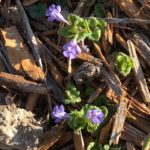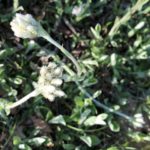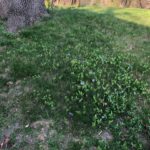Years ago, a homeowner visited a garden store and bought plugs of a plant commercially called ground ivy, but most folks today call it Creeping Charlie.

A great ground cover that can get away from you.
In many ways this exotic plant was an ideal ground cover. It’s tough, easy to transport and plant, adaptable to a wide range of conditions, needs no special care, and it spreads like crazy. It only grows a few inches tall so was touted as a plant that, once established, needs no maintenance. And, it attracts valuable pollinators early in the season before other flowering blooms appear.
Benefits
Creeping Charlie’s benefits are also its curse. It does everything too well. Creeping Charlie doesn’t creep. Rather, it races to cover a yard with astonishing speed, often crowding out more desirable plants.
There are two ways to view Creeping Charlie.
It’s either a pernicious pest or a friend that needs little care. At Winding Pathways, we look at it both ways depending on where it’s growing. When it’s crowding wildflowers or our garden vegetables we rip it out of the ground. In places where it can’t infect a garden or native wildflowers we leave it be and know we won’t need to mow that area often.
Controlling Creeping Charlie
There are lots of ways to control Creeping Charlie. We pull it out of the ground. Roundup and other herbicides kill it, and it’s possible to smother it under black plastic sheeting. Mulch works for a while but soon the plant will thrive on even a thick layer of shredded wood mulch.
A member of the mint family and also known more romantically by an elderly Irish friend as “Gill-Over-the-Ground”, Creeping Charlie is also edible steamed, added to omelets or brewed as a tea.
Other Ground Covers
We prefer ground covers that are less aggressive than Creeping Charlie. One of our favorites is the native Pussy Toes, which grows in patches in our lawn. We planted some when we moved in eight years ago and because we don’t put herbicides on our lawn it is spreading nicely. It is hardy and thrives in dry, sandy soil in baking sun. The hairy, silvery leaves lie close the ground and in spring send up enchanting stems with little “pussy toe” flowers. The Lady Bird Wildflower Center confirms this native plant is widely spread and thrives in open meadows and woodlands and rocky areas. We’ve seen it all over the eastern half of the country and Canada. We love it! Again, it saves mowing, adds color and texture to the landscape and attracts early season pollinators.
We also use Vinca, with its periwinkle flowers, on some parts of our lawn especially areas we do not want to mow. It spreads easily, adds color and texture to the landscape and reduces maintenance.
- Pollinators like ants flock to pussytoes.
- An excellent ground cover.
- Pretty purple violets.
Our lawn actually is a mosaic of many plants. Since we shun herbicides we have a lawn blend of grasses, violets, dandelions, pussytoes, and many other plants. They are all fascinating and help pollinators through the seasons.





I read Nature’s Note in The Gazette on the first of July. The article was about Poison Hemlock. The picture was not good. So how does one recognize it? We have a large plant (up to six feet). The leaves are lacy and the stock woody and hollow. It has a white cluster of flowers not unlike Queen Anne’s lace.
Hi Dixie: Try looking up poison hemlock on line and go to images. See how that works.